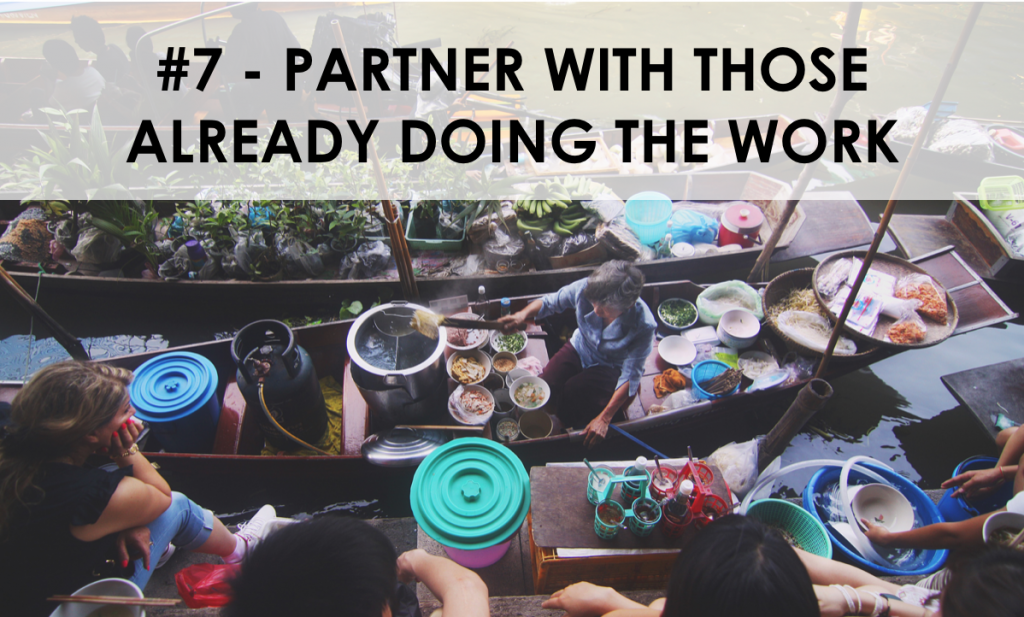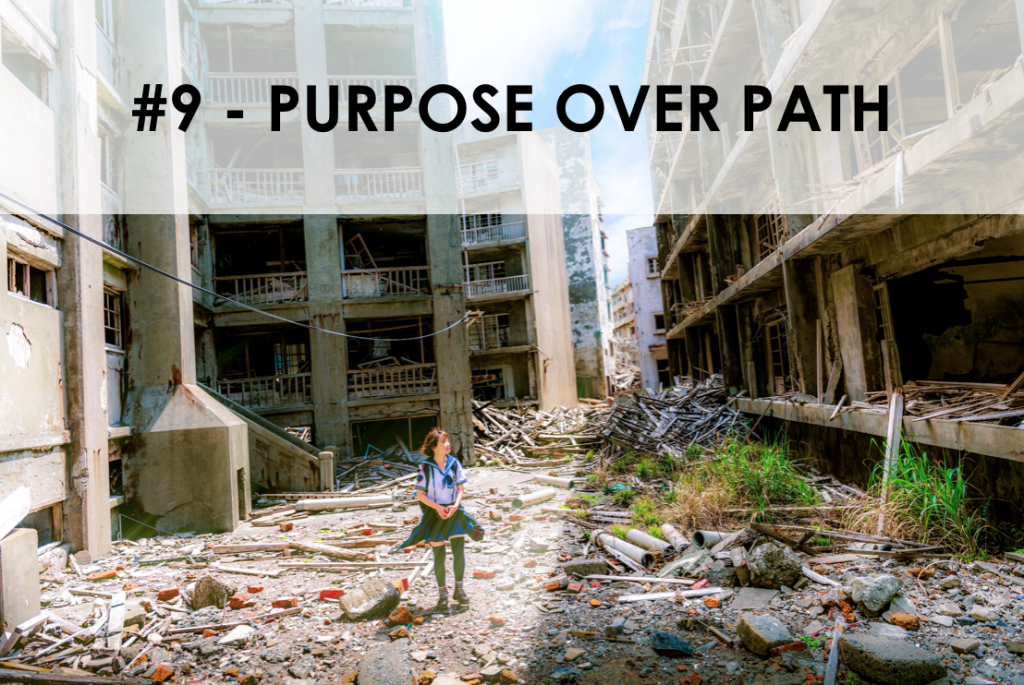Have you ever looked back and thought to yourself, “wow, I definitely would have approached that differently if I were starting over…”.
I’m sure we all have, and I’m sure it’s especially true when starting a new business or project.
Starting and running a profitable business is hard. Delivering outstanding programs or offerings that truly improve the lives of those you serve as a social entrepreneur is also hard.
Doing both is much harder. At times it can even feel impossible to join these sometimes conflicting goals in harmony.
I wrote this post because my hope is that sharing these 9 tips will speed up the learning curve for social entrepreneurs just starting out.
Not all of these tips apply to every social business, or social enterprise, so take in what resonates with you and leave the rest. After all, there is no wrong way of building business. Plus, keep in mind this list is not necessarily in order of importance! The most important factors when starting out will depend on your unique strengths, the environment you operate in, and your social impact goals.
In Part 1 of this series, we talked about how social entrepreneurs might want to consider:
#1 – STARTING SMALL
#2 – GOING MANUAL FIRST
#3 – COMBATING OVERWHELM WITH AWARENESS & SIMPLICITY
#4 – FINDING THE FASTEST PATH TO THE CASH
Read Part 1 here or continue reading the final 5 top considerations when starting the social business of your dreams.
I would venture so far as to say this is the single most important key to success in any business, social or traditional. Missing this piece results in no business at all.
Listening to your customers is not just asking them what they think of your product or service. It is observing how they react and interact with your business. Customers are notorious for saying one thing and doing another. The truest proof of concept is having customers or beneficiaries taking actions that support your work, not just saying they like your work.
Some of the best learning comes from examples of when things go wrong. One such example is the initiative PlayPump International, a water pumping solution that grew from an idea in 1997 to 1,000 PlayPumps in 2008 after millions in high profile funding from organizations like Case Foundation and U.S. Agency for International Development (USAID).
After the idea took traction as a game-changer for water collection in sub-Saharan Africa and quickly scaled across 5 countries, evaluations began to point to the inherent challenges of the innovation. This case study reveals one of the biggest issues being that “it never targeted the right need”.
The report points out that in many cases the new PlayPumps were installed in communities without full community approval and buy in. What’s worse is that the traditional hands pumps were removed, later to be confirmed taking 28 seconds to fill a water bucket compared to the 3.5 minutes it took to fill the same bucket using the PlayPump.
Will you always get your offering perfectly matched to the needs and desires of your customers and beneficiaries the first time you present it? No. But that’s ok. This learning is all part of the process of building a strong social business — as long as you’re willing to adapt as you gain new information about what your customers DO really want and need.
This post from Seth Godin describes it perfectly,
“Those critical choices you made then, they were based on what you knew about the world as it was. But now, you know more and the world is different.”
[Tweet “#Listen: Customers are notorious for saying one thing and doing another. Observe their actions and adapt your offering as needed.”]
Social entrepreneurs are naturally system thinkers, often seeing complexity and grey areas where others see black and white. This is a strength for spotting opportunities for creating value in unexpected places, but it can also be a hurdle to overcome when communicating messages that matter and stick.
For example, I coached a social entrepreneur who has developed a brand new processing method for seaweed that transforms it into powerful all-natural fertilizer that not only stimulates growth in plants, but allows for greater water retention in the soil — essential for successful agriculture in drought areas like East Africa.
As he presents his business opportunity, the challenge is choosing the most relevant information to share with to portray the product’s scope of impact without loosing the listener in confusion and classic ‘I.O.’ (Information Overload).
The reality is that his innovation can significantly impact a wide range of industries, countries, and people. But it wouldn’t make sense to communicate every angle of the business in the first conversation with someone, because they would leave more confused than ever!
Thinking in ‘systems’ as a social entrepreneur allows you to envision the big picture of how your social business fits together. You understand the ‘secret sauce’ of how your social enterprise delivers game-changing impact. It doesn’t mean your listener sees the game being changed in the same way you do, at least not right away.
You see the value your social enterprise provides on eight different levels, but you only need to ‘sell’ your listener on one. On the one that matters the most to them. If you try and deliver too much information at once, all of it will be lost.
Whether you’re talking to a potential customer, a beneficiary using your services, or an investor, your messaging needs to first address what they want to hear. In other words, the key point that is most relevant, timely, or solving an immediate concern of theirs. Only once they are ‘sold’ on the concept that relates directly to them can you elaborate to paint the detailed picture of what is fully possible through your work.
You know you have your messaging nailed when you can describe the value you deliver in one clear sentence. If people are still giving you confused looks after this sentence, keep refining. Get a communications or business coach, join a local Toastmasters chapter, or see if your city has a Social Venture Partners that hosts a FastPitch event.
[Tweet “#SellThemFirst: You see the value of your project on 8 different levels, but you only need to ‘sell’ you listener on the 1 that matters most to them. #SocialEntrepreneurs”]
As a social entrepreneur, you are in the unique position of doing business differently.
And one of the best ways to succeed in something is to learn from those ahead of you on the learning curve.
Depending on your goals, the unique circumstances of the community you’re working in, and the vision for change that you’re hoping to achieve, it may make sense to partner with others doing the same, or similar, work before branching out to start a new social enterprise initiative.
Partnering could take the shape of volunteering or working with an established project.
Especially if you’re tackling a huge and complex social or environmental challenge, partnering could shave years off progress by leveraging existing structure, resources and community social capital.
Choosing to first volunteer or work with an established organization means your passion and unique talents could take an established project or social business to the next level, moving everyone closer to impact goals.
Alternatively, the experience will allow you to notice gaps or needed improvements, or envision how your idea can build off of and expand the good work others are already doing.
Or, it could mean forging strategic partnerships and collaborations early on in the development of a social enterprise.
For many reasons, it could make sense to start a brand new initiative. In this case, partnering or collaborating with existing organizations, or individuals with similar goals, can fill the skills or resource gaps in both projects, and possibly avoid completely reinventing the wheel!
For more tips on building strong collaborations and partnerships, see this recent blog post, watch highlights from the first Live #SOCENT Lab session, or join our new collaborative Q&A community for social entrepreneurs around the world: The Global #SocEnt Lab.
[Tweet “#Collaborate: Partnering could shave years off progress by leveraging existing structure, resources and community social capital #tips”]
Prevailing economics and traditional business are generally obsessed with growth. Grow fast, grow big, and grow above all else.
The funny thing is that the prevailing obsession with growth and more has indeed trickled into the social sphere. It just comes with a shiny new name: scaling.
When talking impact, and realizing the sheer scale of social and environmental challenges facing the world today, it does make a great deal of sense to focus on scaling impact into new markets as quickly as possible so that these new innovations can transform more lives.
It follows from the sheer size of our social challenges that scaling social innovations to be bigger, and deliver value faster, is an absolute necessity, right?
While there is a case for replicating ideas that work across geographic boundaries, there are likewise significant potential downfalls to scaling before you are ready.
When it comes to social businesses, growth cannot and should not necessarily be the driver of decisions that evolve the initiative forward. Developing a social enterprise in a positive way is not automatically synonymous with growth. And growth could in fact be to the detriment of the social mission.
Some scaling methods go completely against the grain of what it means to be socially entrepreneurial.
When a scaling strategy heads to the end of the spectrum where high levels of control are required (such as branching into new offices, or franchising) there is danger of too much bureaucracy and oversight of operations. This can stifle needed adaptations to the local context, and it inherently demands high investment of both time and money from the original social innovator, so also takes much longer to scale.
For instance, the project Village Telco chose to scale their technology using an open source method. (Hear more about the founder’s reasoning in this interview.)
Open source is an excellent example of using a scaling strategy where the social innovation is free to be applied in local context as needed, while at the same time empowering local social entrepreneurs to take ownership and leadership of the project. Because of this freedom, the innovation is likely to spread much quicker and with little to no cost to the original social innovator.
Growing slowly is the only way to consider, unearth and mitigate unintended consequences along the way.
In the PlayPump International example, one unintended consequence that emerged was how the innovation actually isolated women in the community. Water gathering before the PlayPump included customs where women would collect water together. Not only that, but the practice of collecting water communally meant that villagers who could not collect for themselves benefited from collective efforts of others. The PlayPump system was so onerous that women were pumping alone. What’s worse, it took so much effort they were too tired to pump extra for those in need, leaving sick, elderly and disabled without water.
It is imperative to have a strong and proven Theory of Change and Business Model at the core of the social innovation you are looking to scale. As the founder of VisionSpring said, “We’re not in the business of scaling losses”, reiterating that scaling before everything is working predictably on a very small scale is just scaling problems.
So how do you know when you’re ready to scale your social innovation? This article by Stanford Social Innovation Review is a great place to start.
As we see in examples like PlayPump International, there can be a fine balance between scaling proven strategies and scaling problems. When it comes to the topic of growth and scaling, tread carefully.
[Tweet “#GrowSlowly: There can be a fine balance between scaling proven strategies and scaling problems. #socent #tips”]
The final essential consideration when building the social business of your dreams is to never stop checking in with your social enterprise strategy to make sure you’re always choosing purpose over path.
As a social entrepreneur it’s your job to fall in love with the problem and not with the solution you have designed to solve it. Yes, you want to keep a steady eye on the long-term vision for the change you wish to see. But the path, or solution, that you take to get there can come in a variety of shapes and sizes.
Sometimes, we can fall so passionately in love with the specific solution, or the vehicle we see driving to the long-term vision, that sticking to that solution gets in the way of navigating the best path for achieving the purpose goal(s).
Back to the PlayPump International example: once the evaluations came back with conclusions about the drawbacks and challenges of the PlayPump innovation, it was clear that PlayPumps alone were not going to serve as a blanket solution for providing safe and clear water in sub-Saharan Africa.
In 2010, PlayPump International had to make a tough decision. But, it was one that wholly aligned with the problem they were trying to solve, and was not based on a feeling of obligation to carryon as planned with the solution they first implemented.
Because of this, in 2010 all of PlayPumps International’s assets were donated to the nonprofit Water for People so the innovation could be available to be applied as needed within a broader mix of solutions.
This decision shows achieving the end goal of safe and clean water for all was more important to the founders than keeping ownership of their idea in it’s original state. They detached from controlling the path of the solution, and acted with a dedication to the problem in mind.
[Tweet “#PurposeOverPath: Fall in love with the problem and change you wish to see, not with the solution you have designed to solve it. #socent #tips”]





